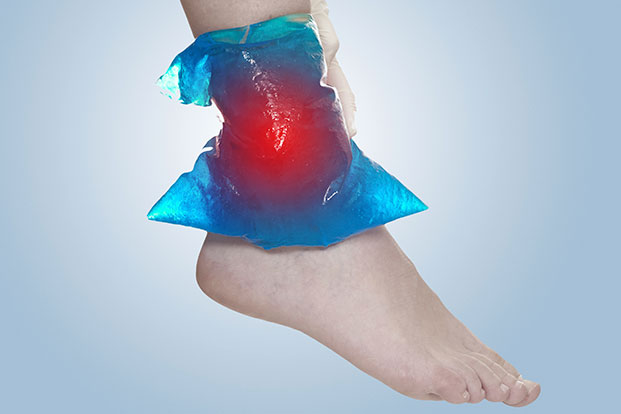A slip in the shower a hop off a ladder One wrong move, and suddenly you’re out of commission. While the injury isn’t necessarily cast-worthy, a sprain can be painful, and the healing process can be painstaking.
The good news is that you can make the most of your recuperation time by following a few helpful hints that will speed up the recovery process – and have you back on your feet before you know it.
What and Where We Sprain
A sprain is an injury to a ligament, the tissue that connects two or more bones at a joint. When one or more ligaments is stretched or torn, a sprain occurs. (Equally painful can be a strain, an injury to a muscle or a tendon, the tissue that connects muscle to bone. In a strain, a muscle or tendon is stretched or torn.)
What do we sprain? The most common place is the ankle, followed by the wrist after a fall. We even sprain our thumbs often, and twisting a knee may mean a sprain. Many strain their backs and hamstring muscles in the backs of the thighs.
How do you know your injury is a sprain? The common symptoms are:
Pain
Swelling
Bruising
Not being able to move or use the joint
Always check with a medical professional if your symptoms are extreme and pain is severe. But if you are diagnosed or know that it is a sprain that can be healed at home, there is a simple approach.
The R.I.C.E Approach
Just remember for simple words: rest, ice, compression, elevation. Known as the R.I.C.E. Approach, these are immediate self-care musts.
Rest. We all know that rest is a key component of repairing the body. Specifically with sprains, avoid activities that cause pain, swelling or discomfort in the affected area. But don’t skip all physical activity, including moderate exercise for other areas of the body.
Ice. Ice should be used immediately on a sprain. It reduces the inflammatory response and pain associated with heat generated by increased blood flow and blood loss.
TIP: Use an ice pack or slush bath of ice and water for 15 to 20 minutes each time and repeat every two to three hours while you’re awake for the first few days following the injury. Cold reduces pain, swelling and inflammation in injured muscles, joints and connective tissues. It also may slow bleeding if a tear has occurred.
CAUTION: If the affected area turns white, stop ice treatment immediately – it could mean frostbite. And if you have diabetes or a vascular disease or develop decreased sensation, talk with your doctor before applying any or more ice.
Compression. Use an elastic bandage instead of a firm plastic bandage (such as zinc-oxide tape) to help compress the area and help stop swelling until the swelling stops. Don’t wrap it too tightly, or you may hinder circulation. The fit should be snug so as to not move freely, but still allow expansion when muscles contract and fill with blood.
TIP: Begin wrapping at the end farthest from your heart and loosen your wrap if the site of the injury becomes numb, swelling occurs under the wrapped area or pain increases.
Elevation. To reduce swelling, elevate the injured area above the level of your heart. Gravity helps reduce swelling.
TIP: Elevate especially at night.
Health experts at The Mayo Clinic note that in most cases beyond a minor strain or sprain, you’ll want your doctor and physical therapist to help you with this process.
Your favorite over-the-counter pain medication may be your new best friend as you recover from a sprain. These include ibuprofen (Advil, Motrin IB, others) and acetaminophen (Tylenol, others). Even if tempted by pain, follow the instructions and don’t overdo it.
How to Pace Yourself
It will be a waiting game. Mild and moderate sprains usually don’t heal completely for three to six weeks, experts say.
Start immediately with R.I.C.E, and then after the first two days, slowly begin to use the injured area. You should see a gradual, progressive improvement in the joint’s ability to support your weight or your ability to move without pain. A physical therapist can help you maximize stability and strength of the injured joint or limb.
Prevention is Key
While some injuries are freak accidents, others can be avoided with the proper precautions.
Preventing Sports Injuries
For sports enthusiasts, The American Academy of Orthopedic Surgeons has outlined simple tips to help reduce injury risk:
Participate in a conditioning program to build muscle strength
Do stretching exercises daily
Always wear properly fitting shoes
Nourish your muscles by eating a well-balanced diet
Warm up before any sports activity, including practice
Use or wear protective equipment appropriate for that sport
Preventing Falls
Falls are one of the leading causes of sprains and the leading cause of emergency room visits.
“The nation’s emergency physicians are prepared to care for anyone injured from a fall,” said Dr. Sandra Schneider, spokesperson for the American College of Emergency Physicians. “But it’s important to look around your everyday environment and minimize the risk to not only for yourself, but for others as well.”
They can happen at any time, in any place and to anyone, she added.
The College offers these simple tips for fall prevention:
Remove clutter from your home. Don’t leave objects on stairs or walkways.
Use nightlights in the bedroom, hall and bathroom. Be sure the tops and bottoms of stairs are well lit.
Repair loose stairway carpeting or boards.
Consider adding hand grip bars in bathroom and shower areas, especially for the elderly or those with disabilities for those at home and visiting.

Leave a Reply